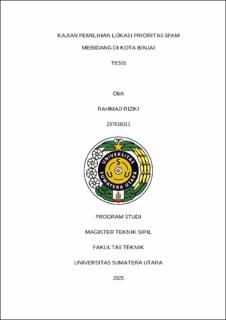Kajian Pemilihan Lokasi Prioritas SPAM MEBIDANG di Kota Binjai
Study on The Selection of Priority Locations for SPAM MEBIDANG in Binjai City

Date
2025Author
Rizki, Rahmad
Advisor(s)
Anas, M Ridwan
Mulia, Ahmad Perwira
Metadata
Show full item recordAbstract
Currently, PDAM Tiratasari is facing significant challenges in providing optimal drinking water services to the residents of Binjai City. The main issues stem from the low level of service caused by limited production capacity and an inadequate distribution pipeline network. This situation arises because PDAM Tiratasari relies solely on a single Water Treatment Plant (IPA), namely IPA Marcapada, which is insufficient to meet the growing demand for clean water in line with population growth and regional development. As a strategic effort to increase production capacity and expand the distribution network, the Regional Drinking Water Supply System (SPAM) Program for the Mebidang area—covering Medan, Binjai, and Deli Serdang—has become an essential solution. The Mebidang SPAM, sourced from the Bingei River in Binjai City, has been inaugurated and is designed to serve up to 88,000 household connections or approximately 440,000 people, with a production capacity of 1,100 liters per second. This program is the result of synergy between the central, provincial, and local governments, and is expected to significantly improve access to safe drinking water, particularly in the priority development areas of Binjai Utara and Binjai Timur subdistricts. This study aims to determine the priority areas for the development of the Main Distribution Network (JDU) of the Mebidang SPAM in Binjai City, in order to support improved water service delivery amidst the government’s policy of budget efficiency as stipulated in Presidential Instruction Number 1 of 2025. The analysis employed includes a technical hydraulic scheme analysis using the EPAnet application to model water distribution, as well as the SMART (Simple Multi Attribute Rating Technique) method to determine area priorities based on technical criteria, community needs, and budget efficiency. Through this approach, it is expected that the JDU development can be implemented effectively, efficiently, and accurately, in accordance with community needs and government policies.
Collections
- Master Theses [278]
